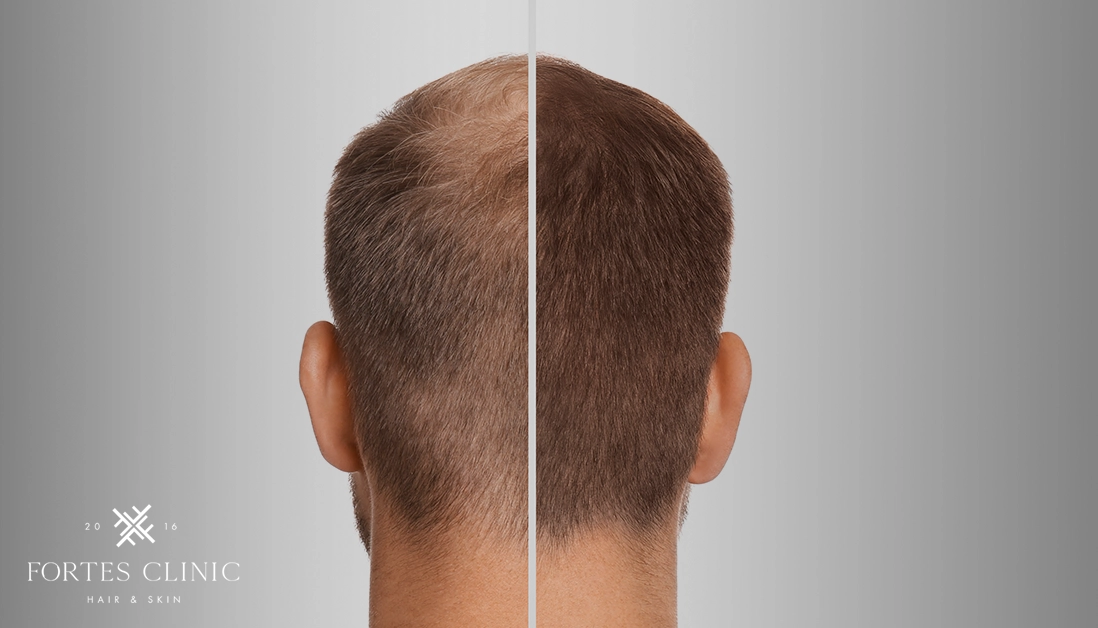Introduction
Hair transplants are one of the most sought-after solutions for people experiencing hair loss, offering permanent and natural-looking results. However, a common question that arises for many potential patients is, how painful is hair transplant surgery? While the prospect of surgery may cause concern, advancements in medical techniques and anaesthesia have made the process significantly more comfortable than many assume.
In this article, we will explain what to expect in terms of discomfort during and after the procedure, how pain is managed, and why Fortes Clinic is the trusted choice for a comfortable and expert hair transplant experience.
If you’re unsure how the procedure works, we recommend reading our post on how a hair transplant works.
How Painful Is Hair Transplant Surgery During the Procedure?
Hair transplants, whether performed using FUE (Follicular Unit Extraction) or FUT (Follicular Unit Transplantation), are considered minimally invasive procedures. Both techniques are carried out under local anaesthetic, which numbs the scalp entirely. Most patients report feeling little to no pain during the actual surgery. Instead, they may describe a slight pressure or sensation as the follicles are extracted and implanted.
The initial injection of the local anaesthetic may cause mild discomfort, similar to a pinch or small sting. However, once the area is numb, the rest of the procedure is typically pain-free. Surgeons at Fortes Clinic take additional steps to ensure patients remain comfortable throughout.
To learn more about FUE, visit our FUE hair transplant page. For FUT, see our guide to FUT hair transplants.
How Painful Is Hair Transplant Recovery?
Some minor discomfort may be experienced after the anaesthetic wears off. This is usually described as a mild tenderness or tightness in the donor or recipient areas. Most patients compare it to the feeling of a light sunburn. Any discomfort typically subsides within a few days.
Over-the-counter pain relief, such as paracetamol, is usually sufficient to manage any post-operative soreness. In some cases, the clinic may provide medication to ease the healing process further. Swelling or minor scabbing may also occur, but these are normal parts of recovery and are not generally associated with significant pain.
In addition to physical sensations, it’s common for patients to feel a bit anxious in the days following surgery, particularly as they adjust to caring for the treated areas. The team at Fortes Clinic offers ongoing support and advice to ensure patients feel reassured and well looked after.
Many patients are surprised by how quickly they are able to return to their daily activities. Some even resume remote work or light tasks within a day or two, which further reassures those concerned about downtime or prolonged discomfort.
Pain Management at Fortes Clinic
At Fortes Clinic, patient comfort is a top priority. From the consultation stage through to recovery, our team ensures every individual receives a tailored experience. During the procedure, experienced surgeons carefully apply anaesthetic and monitor the patient’s comfort level continuously.
We also provide a clear and detailed aftercare plan to help reduce any potential discomfort after the procedure. Patients are encouraged to reach out with any concerns and have access to follow-up care as needed. Our commitment to a smooth and pain-minimised process is one of the many reasons patients choose us.
Fortes Clinic also ensures the clinical environment is calm, welcoming, and supportive, further easing the emotional and physical aspects of undergoing a hair transplant. Our highly experienced team has performed thousands of procedures and understands how to manage discomfort effectively.
Our staff also educate patients on what to expect throughout each phase of the healing process, allowing them to feel fully informed and in control. This proactive approach significantly reduces uncertainty and stress.
Minimising Hair Transplant Discomfort During Recovery
While the healing process is typically straightforward, there are steps patients can take to further reduce any discomfort:
- Follow the aftercare instructions carefully.
- Avoid touching or scratching the treated areas.
- Sleep with your head elevated for the first few nights.
- Avoid strenuous activity and direct sun exposure for the first week.
- Use prescribed or recommended products to soothe the scalp.
These steps not only help reduce pain but also support the successful growth of the transplanted hair.
In some cases, patients may also benefit from using cold compresses on the forehead to manage swelling, though this should be done with care and under guidance. Staying well-hydrated and maintaining a healthy diet can also aid in a faster and more comfortable recovery.
Wearing loose-fitting hats or avoiding friction from pillows can also protect sensitive areas during the initial recovery phase. Taking short breaks throughout the day to rest and avoid exertion further contributes to a more comfortable post-procedure period.
For more on what to expect after the procedure, read our post on hair transplant recovery time.
Does the Type of Hair Transplant Affect Pain Levels?
FUE and FUT are the two most common methods of hair transplantation, and the level of discomfort may vary slightly between them.
FUE, which involves removing individual follicles, is less invasive and typically associated with a faster, more comfortable recovery. FUT involves removing a small strip of scalp, which may cause slightly more discomfort due to the stitches required in the donor area. However, even with FUT, pain is minimal and manageable with proper care.
Some patients find the slight post-operative tightness from FUT more noticeable, but this sensation usually fades within a few days. Ultimately, both techniques are designed to minimise pain and ensure patient comfort.
The choice between the two methods should be based on hair restoration goals, donor area condition, and surgeon recommendation rather than pain alone.
Conclusion: How Painful Is Hair Transplant Surgery?
So, how painful is hair transplant surgery? The truth is, it’s far less painful than many expect. Thanks to local anaesthesia, most patients feel little to no pain during the procedure, and any post-operative discomfort is usually mild and short-lived.
At Fortes Clinic, we prioritise patient comfort and provide expert care before, during, and after your hair transplant. Our experienced team is dedicated to making the journey as smooth and painless as possible.
If you’re considering a hair transplant but are worried about discomfort, we invite you to book a consultation and learn more about how we make the experience comfortable and rewarding. You don’t have to let the fear of pain stop you from restoring your confidence and achieving your hair goals.



